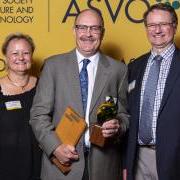 | Dr Rob Bramley Senior Principal Research Scientist - CSIRO Agriculture and Food, Precision Agriculture Site Leader – CSIRO Waite Campus Adjunct Professor, Tasmanian Institute of Agriculture / University of Tasmania Scarlett, N. , Bramley, R. and Siebert, T. (2014), Within-vineyard variation in the ‘pepper’ compound rotundone is spatially structured and related to variation in the land underlying the vineyard, Australian Journal of Grape and Wine Research, 20: 214-222. doi:10.1111/ajgw.12075 |
The 2018 Dr Peter May award was awarded to Dr Rob Bramley CSIRO Agriculture and Food for the paper; Within-vineyard variation in the ‘pepper’ compound rotundone is spatially structured and related to variation in the land underlying the vineyard Work conducted by the AWRI in the early to mid-2000s led to the identification of rotundone as the compound that is responsible for the distinctive ‘spicy’ and ‘peppery’ aroma and flavour of some cool climate Shiraz wines. In particular, the Grampians region of Victoria was identified as producing wines with this desirable peppery character. Meanwhile, work conducted principally by Rob Bramley (CSIRO), much of it through the then Viticulture CRC, had identified vineyards as being markedly spatially variable, with consequent opportunities for various forms of targeted management, including selective harvesting, which was shown to be potentially highly profitable. In his role as National Technical Viticulturist with the Rathbone Wine Group, Nathan Scarlett was curious to know whether, in addition to the pronounced regional variation in the ‘pepperiness’ of Shiraz, there was also spatial variation at the within-vineyard scale. If there was, then through strategies such as selective harvesting, he thought it might be possible to exert control on the pepperiness of final wines through actions in the vineyard. In brief, the work demonstrated that rotundone did indeed show marked spatial variation (which has since been shown to be stable over different seasons in spite of marked variation in the annual mean rotundone concentration) and that this could be attributed to variation in the land underlying the vineyard in terms of its topography and soil. This paper, which has now led to the development of a much larger program of work being undertaken by AWRI and CSIRO with support from Wine Australia, reports the results of that initial investigation initiated by Nathan Scarlett. The work is significant in being the first ever demonstration of spatial variation at the within-vineyard scale of a grape-derived wine flavour and aroma compound. However, possibly its greatest significance is that, for the most part, it was undertaken without any sort of structured funding support and purely on the basis of the goodwill of those involved in the work, who saw the merits of pursuing a good idea when they saw one. Hopefully, there is a lesson in that for all ASVO members and others involved in Australian viticultural and oenological research.









